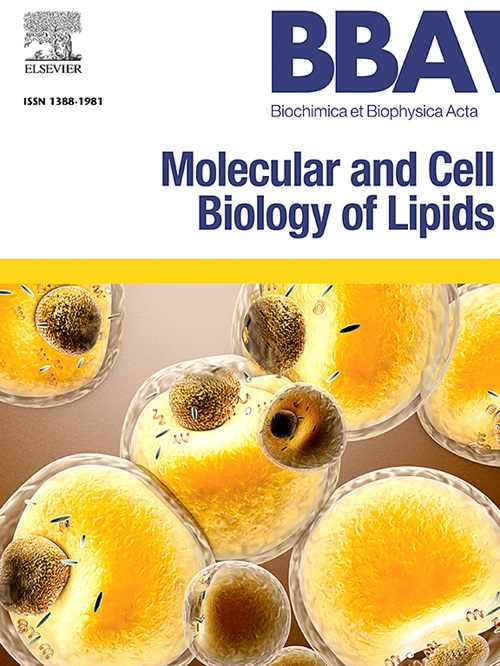Induction of ectosome formation by binding of phospholipases D from Loxosceles venoms to endothelial cell surface: Mechanism of interaction
IF 3.3
2区 生物学
Q2 BIOCHEMISTRY & MOLECULAR BIOLOGY
Biochimica et biophysica acta. Molecular and cell biology of lipids
Pub Date : 2024-11-14
DOI:10.1016/j.bbalip.2024.159579
引用次数: 0
Abstract
Members of the phospholipase D (PLD) superfamily found in Loxosceles spider venoms are potent toxins with inflammatory and necrotizing activities. They degrade phospholipids in cell membranes, generating bioactive molecules that activate skin cells. These skin cells, in turn, activate leukocytes involved in dermonecrosis, characterized by aseptic coagulative necrosis. Although the literature has advanced in understanding the structure-function relationship, the cell biology resulting from the interactions of these molecules with cells remains poorly understood. In this study, we show that different cells exposed to recombinant PLDs bind these molecules to their plasma membrane, leading to the subsequent organization of extracellular microvesicles/ectosomes. The binding occurs as quickly as five minutes or less after exposure, increases over time, and eventually, the PLDs are expelled from the cell surface without generating cytotoxicity. PLDs are not endocytosed, nor do they spatially colocalize with acidic organelles in the intracellular environment. At least two regions of PLDs – the domain involved in magnesium ion coordination and the choline binding site – appear to play a role in cell surface binding and ectosome organization. However, the amino acids involved in catalysis do not participate in these events. The binding of these PLDs to the cell membrane, independent of catalytic activity, is sufficient to trigger intracellular signaling and enhance the expression of the pro-inflammatory IL-8 gene. These results are supported by the observation that isoforms of PLDs lacking catalytic activity induce an inflammatory response in vivo when injected into the skin of rabbits, without causing dermonecrosis. Our data indicate that these PLDs bind to the surface of target cells, promoting the organization of extracellular vesicles/ectosomes. Subsequently, these events activate pro-inflammatory genes and induce an inflammatory response in vivo. The binding to cells is not dependent on amino acids involved in catalysis but rather on amino acids involved in magnesium coordination. The binding of PLDs to the cell surface, formation of ectosomes, and activation of cells appear to initiate signals involved in inflammatory responses that can lead to dermonecrosis in accidents. This correlation is supported by experimental observations indicating that the events of toxin binding to cells, formation of microvesicles, and inflammatory responses observed both in vitro and in vivo are interconnected.
洛索蛇毒液中的磷脂酶 D 与内皮细胞表面结合诱导外小体形成:相互作用机制。
蛛毒中的磷脂酶 D(PLD)超家族成员是一种具有炎症和坏死活性的强效毒素。它们会降解细胞膜中的磷脂,产生生物活性分子,从而激活皮肤细胞。这些皮肤细胞反过来又会激活白细胞,使其参与以无菌性凝固性坏死为特征的皮肤坏死。虽然文献对结构与功能关系的理解有所进步,但对这些分子与细胞相互作用所产生的细胞生物学特性仍然知之甚少。在这项研究中,我们发现不同的细胞在接触重组 PLDs 后会将这些分子与细胞质膜结合,进而形成细胞外微囊/小体。这种结合在暴露后五分钟或更短时间内迅速发生,并随着时间的推移而增加,最终,PLDs 被排出细胞表面,而不会产生细胞毒性。PLDs 不会被内吞,也不会与细胞内环境中的酸性细胞器发生空间共聚。PLDs 至少有两个区域--参与镁离子配位的结构域和胆碱结合位点--似乎在细胞表面结合和外泌体组织中发挥作用。然而,参与催化的氨基酸并不参与这些活动。这些 PLD 与细胞膜的结合与催化活性无关,但足以触发细胞内信号传导并增强促炎 IL-8 基因的表达。缺乏催化活性的 PLDs 异构体被注射到兔子的皮肤中会诱发体内炎症反应,但不会导致皮肤坏死,这一观察结果为上述结果提供了佐证。我们的数据表明,这些 PLDs 与靶细胞表面结合,促进了细胞外囊泡/小体的组织。随后,这些事件会激活促炎基因,诱发体内炎症反应。与细胞的结合并不依赖于参与催化的氨基酸,而是依赖于参与镁配位的氨基酸。PLDs 与细胞表面的结合、外泌体的形成和细胞的活化似乎启动了参与炎症反应的信号,而炎症反应可导致意外的坏死。实验观察结果表明,毒素与细胞结合、微囊的形成以及在体外和体内观察到的炎症反应是相互关联的。
本文章由计算机程序翻译,如有差异,请以英文原文为准。
求助全文
约1分钟内获得全文
求助全文
来源期刊
CiteScore
11.00
自引率
2.10%
发文量
109
审稿时长
53 days
期刊介绍:
BBA Molecular and Cell Biology of Lipids publishes papers on original research dealing with novel aspects of molecular genetics related to the lipidome, the biosynthesis of lipids, the role of lipids in cells and whole organisms, the regulation of lipid metabolism and function, and lipidomics in all organisms. Manuscripts should significantly advance the understanding of the molecular mechanisms underlying biological processes in which lipids are involved. Papers detailing novel methodology must report significant biochemical, molecular, or functional insight in the area of lipids.

 求助内容:
求助内容: 应助结果提醒方式:
应助结果提醒方式:


